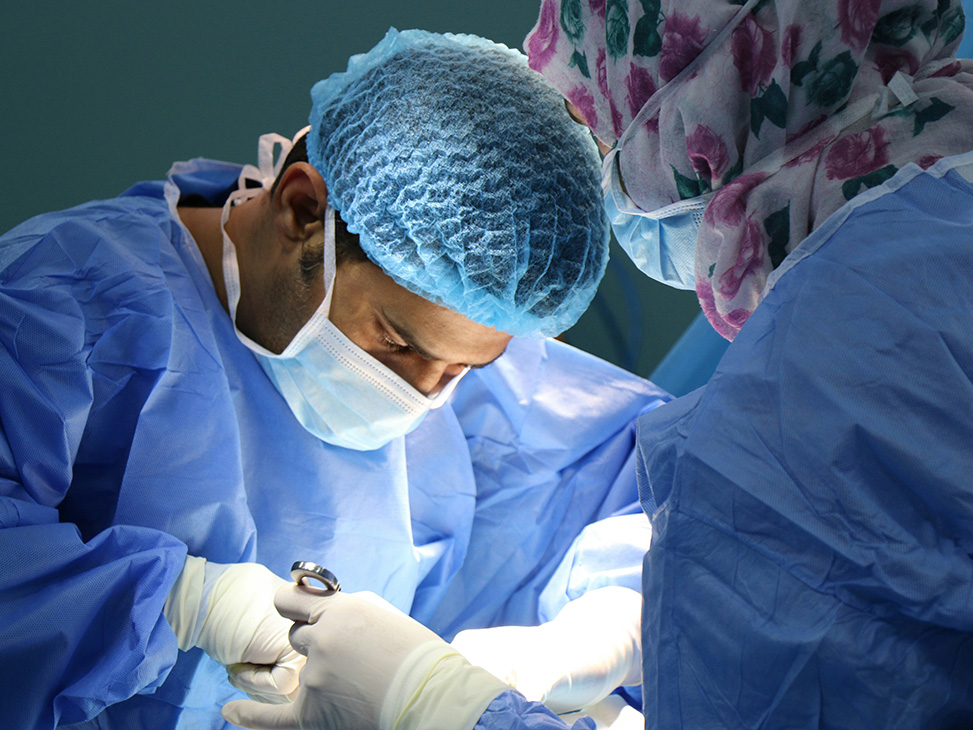Home / Surgical Solutions / Non-Binary Top Surgery

In order to understand what non-binary is let’s start with basic, most commonly accepted definitions and distinguishing factors between assigned sex and gender identity:
It is important to note that non-binary gender identities are not ‘new identities’ or new concepts and have been recognised throughout the world for a very long time. Those who identify as non-binary may use pronouns outside of the binary such as they/them. However, there are many other gender-neutral pronouns and pronoun combinations (such as he/they, she/they) that people use so it’s always best to ask what someone’s pronouns are when initiating a conversation for the first time. Cosmedicare adopt this approach from our first contact with you.
Transitioning/aligning as a non-binary person can be medical (taking hormones, getting surgery) or non-medical (using different pronouns, binding, changing hair or clothing style). You may or may not already be engaged in medical transitioning. Since gender is a spectrum someone who identifies as non-binary, genderqueer, agender etc. may express their gender neutrally, masculine, feminine, a combination of all or some of these.
Technically all aspects of anatomy are non-binary if someone identifies as such. What we’re exploring is finding congruence between one’s non-binary identity and a physical presentation to the world through a gender affirming surgery, essentially helping you match how you feel on the inside with how you look on the outside. There’s no one answer to this question, which is why a full consult is required as this can provide opportunity to discuss available surgical options. Most commonly a second consult is offered prior to any surgery. This way you can make an informed decision on what surgical options may fit your needs.
You can think of gender-neutral top surgery results like we think of non-binary. There are a huge number of valid expressions of gender which fall within the broad category of non-binary. Similarly, there are a number of top surgery features where the result could be modified to a patient’s liking so they hold the results toward whatever it is that they personally consider to be non-binary.
It can get a bit confusing to think about all the different things in a top surgery result which can be modified and what it means to have a particular result look more male or more gender-neutral. Due to this the best way of discussing gender neutral results is to start with what might be considered the ‘ideal binary male’ top surgery result.
From there we can discuss its binary features and then how those features could be modified to an individual’s preference to express a more non-binary appearance.
Incisions and Chest Contours as well as Nipple and Areola Options content is a great starting place in learning more about non-binary top surgery.
Binary Male Appearing Chest Incisions
For patients interested in having a binary male appearing chest there are some modifications to the shapes of incisions that could achieve this listed below:
Less Binary (or non-binary) Appearing Chest Incisions
Below are a few incisions requests we’ve received from patients who are interested in having more non-binary appearing incisions.
It’s important to note that the fish mouth procedure results in an incision across the very center of the chest horizontally. This could be a very popular non-binary procedure choice as most people don’t view the post-surgical results as a chest that was developed through an estrogenic or androgenic pubertal development period.
A typical masculine chest has a fairly uniform requirement for contour. There should be a uniform thickness of tissue throughout the entire chest area, matching the surrounding regions which are beyond the area of surgery. Meaning:
This may be one of the areas where there is the highest degree of variation among different procedure types. For example, with the Inverted T and Buttonhole procedure:
In cases where a patient has a particular wish regarding the exact amount of chest tissue to be left over, I highly advise them to bring in photos of bodies that have the amount of chest tissue that they would be hoping to have at the conclusion of surgery. This helps to avoid any misunderstandings regarding what the procedures can offer and what the limitations of each procedure type are for a given body type are.
The areolas are the wide (usually circular) pigmented area that also contains the nipple. The nipple (in plastic surgery terms) is the only part that projects outward from the chest and is usually somewhat cylinder shaped.
During a top surgery procedure, the areolas are usually resized to the diameter of 22mm (about the size of a nickel) and is most commonly made to be circular. 22 mm is the average size of someone who was assigned male at birth (AMAB).
Most often, if a non-binary individual wants to have a less binary appearing areola, they may choose a size that is slightly larger in diameter (usually 25 to 26 mm). This slightly larger areola options is about the size of an American quarter or a European One Euro coin.
Though complications are uncommon, all surgeries carry a degree of risk and uncertainty. It is possible that you will experience a complication during recovery which will necessitate more time off from work and other daily routines. Complications associated with top surgery include adverse reaction to anesthesia, blood clots, infection, excess fluid build-up in your chest, pain, bleeding and undesirable cosmetic outcome.
While exploring non-binary and gender-neutral content it’s important to keep in mind the following:
Looking to discuss the binary features of our procedures and how those features could be modified to your preference to express a more non-binary appearance? Reach out to us to start your journey.
When you are able to return to work will depend on your role and how physical your day to day work in. Most patients feel up to resuming sedentary work and light physical activity within 7 to 9 days.
You'll need enough time off work for both surgery and recovery. Our team will provide you with a doctor’s note regarding your activity restrictions. The note will not include any information regarding the nature of your procedure. Your employer is not required to know what type of procedure you have undergone.
Depending on your type of procedure your mobility will usually be limited for the first several days, but it is recommended that you start walking as soon as possible. Normal showering will be restricted until the dressings over your incisions and drains (if you have them) are removed. This usually happens within 3 to 7 days.
3 weeks after surgery you can begin to lift up to 20 lbs and do cardio exercise like running / cycling / elliptical training. At 6 weeks there is no weight limit limitation - unless your procedure included a horizontal incision across each side of the chest.
Any physical activity that may cause your heart rate to increase or for you break out in a sweat should be avoided for at least three weeks. Heavy lifting and chest exercises should be avoided for at least 5 to 6 weeks.
If your procedure included a horizontal incision across each side of the chest (double incision, buttonhole, inverted T, fish mouth), then you should avoid elbow-over-shoulder arm positions for up to 6 months after surgery, because this can put a vertical strain on the scars and make them thicker or much wider.
You can do the vast majority of things in your life without putting your arms above your shoulders, except putting things on high shelves or doing certain sports / physical fitness activities.
If you currently smoke, avoiding tobacco use for at least 3-6 weeks before and after surgery is one of the easiest ways to improve your body’s healing response. In advance of your procedure eating a nutritious diet that contains adequate protein, zinc and vitamin C, all of which have been clinically proven to accelerate healing, is a simple step you can take to help minimise scarring.
Following surgery, it is important to keep your scars out of the sun for at least one year. Over-the-counter topical treatments like Scarguard and Bio-Oil have been shown to speed up wound healing and improve the appearance scars. Using silicon sheeting or compression tape is also effective way to treat scars because they prevent the build-up of collagen that can cause scarring.
It is normal for your chest to be red and sore after FTM/N chest surgery. However if the redness extends 1-2 cm beyond the incision line, or if your skin is very warm or tender or you have a fever measured with a thermometer, you should contact us as soon as possible as infection is extremely rare, but these can be signs of an infection.
If at any time during your recovery you feel a sudden shortness of breath, dizziness, chest pain, or tender, swollen legs, you should get emergency help. These may be signs of a medical emergency.
We understand that procedures like this are a deeply personal decision—and one that comes with many questions. At Cosmedicare, we believe in open, honest communication every step of the way. Thats’s why we’ve tailored FAQs for straightforward answers, helping you feel informed, confident, and fully supported.
When you wake up from surgery, it’s normal to experience some discomfort, swelling and bruising. Your chest will be wrapped in gauze dressings and a compression vest for support. You will need to take medication during your recovery which we will provide. You will also have already gotten a dose of antibiotics during surgery, which will decrease your risk of a post-surgical infection. Depending on the amount of tissue removed, your surgeon might also place temporary surgical drains to collect excess fluid build-up.
You will be required to wear a special surgical bra and/or a compression vest for a few weeks to minimize swelling and to help the skin tighten. Most patients are able to return home, or to a recovery center the same day as their surgery. You will need the help of a friend or family member during the first few days of your recovery. A home care nurse may also be necessary for the first three days to monitor your progress, check your dressings and empty the drain reservoirs if you happen to have drains in place (this is highly unlikely).
Your surgeon will review your healing and final results. We’ll provide expert advice on maintaining your outcome and any additional care. At 3 weeks after surgery you can lift up to 20 lbs and do cardio exercise like running / cycling / elliptical training. At 6 weeks there is no weight limit limitation unless your procedure included a horizontal incision across each side of the chest. At your follow-up appointment our goal is to ensure that your results—and your confidence—continue to flourish.
Our team of expert surgeons provide personalised, safe surgical treatments across a full range of procedures. Every experience is tailored to your individual needs.

Choosing the right incision technique for chest masculinization surgery is a deeply personal decision—and one that depends on your anatomy,

FTM/N chest surgery is a life-changing procedure that requires careful planning and consideration in advance. Because FTM/N chest reconstruction is a

Whether you’re considering cosmetic surgery, weight loss surgery, or any surgical procedure — one of the most important decisions you’ll
Website by Creo Design, part of The Solutions on Demand Group